February 27th, 2007
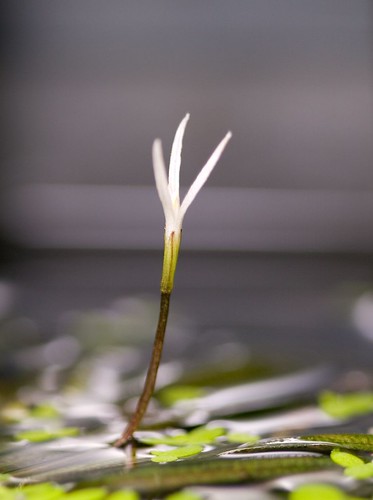 Previously, I’ve posted pictures of my Blyxa aubertii flower. Now, I’ve noticed that some of the Blyxa Japonica, that has been floating toward the top of the surface for some time, has also flowered! From my untrained eye, it’s quite difficult to tell any difference from the two flowers, but I suppose that why the two plants are so closely related.
Previously, I’ve posted pictures of my Blyxa aubertii flower. Now, I’ve noticed that some of the Blyxa Japonica, that has been floating toward the top of the surface for some time, has also flowered! From my untrained eye, it’s quite difficult to tell any difference from the two flowers, but I suppose that why the two plants are so closely related.
In any case, it’s always nice to open up your aquarium hood, and see a pretty little flower waiting there for you.
What may be even more incredible is that this is flowering under 1.5 year old normal output flourescents that are being overdriven. I have a mix of 6500k and 10000k temperature bulbs. I’ve noticed in other tanks that 10000k bulbs have caused flowering, so I’m guessing that these bulbs are holding up okay, even though they’re being overpowered.
Posted in 40G Tank Log, Plant Profiles | 2 Comments »
February 25th, 2007
This weekend, GWAPA held its February meeting at Rob’s house in Herdon, VA. This month, GWAPA demonstrated how to aquascape a tank from start to finish. Ghazanfar and Jeff (president and vice president) worked together to scape a mid-sized tank. (I think it was a 30-40 gallon tank.) The substrate was Soilmaster Select (Charcoal) with a layer of peat underneath. Rob also had some of our wonderful California porous mossy rock, and a number of a plants from the auction. As you can see, the scape turned out pretty nice. It’s glosso in the foreground, with dwarf sag and blyxa japonica in the midground. Finally, pogostemon stelleta ‘broad-leaf’, p. yadabeanus, and some crypts make up the background. After looking at the pictures, the only thing I’d change would be to remove the crypts. Eitherway, pretty good for a couple hours work!
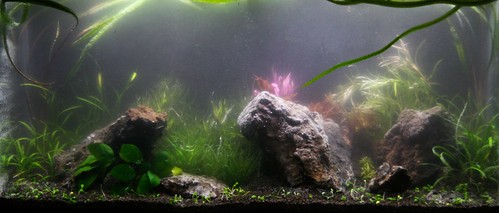
Coming into the meeting, I knew that AaronT (coresponding secretary) wasn’t going to be attending, so I took it upon myself to make sure the auction had plenty of plants. Of course, lots of people bring plants, but Aaron always brings so many exotics that I wanted to make sure it was interesting. Mainly, I just wanted to make sure that I continued to spread around the P. yatabeanus that I had gotten in an auction 2 meetings ago. All-in-all, I brought about 12 bags of plants. What I didn’t expect was to end up the auctioneer! I did my best to keep everything moving along, but I have a new respect for those folks who can get up and really sell items in auctions.
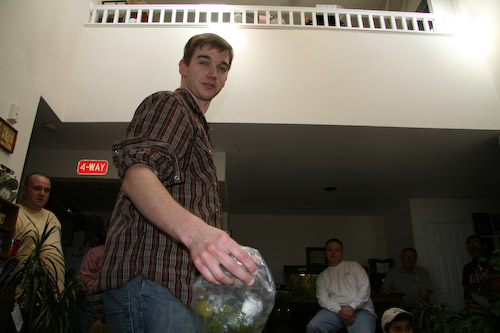
Posted in GWAPA | 3 Comments »
February 22nd, 2007
I haven’t blogged in a little while due to an unexpected trip out of the state due to a family emergency. When these things happen, they don’t always fall conveniently right after a water change, or when your CO2 tank is 100% full. As happens, the timing for my 20G high was quite unfortunate. I had kind of let this tank go a little bit anyways because it seems that some kind of algae spore is embedded in the bogwood, and won’t go away. I didn’t want to pull out the wood because it makes a great shelter for the Apistogramma viejita in this aquarium. So, with an algae outbreak already creeping up, no water change for 2 weeks, and my CO2 tank running out, I came home to this mess.
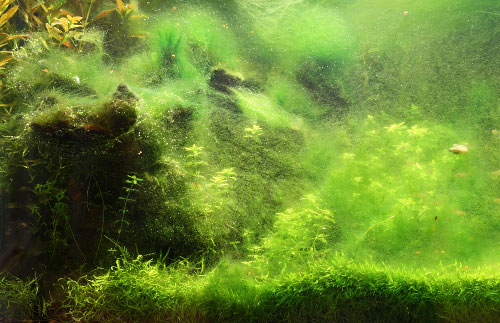
I’m not really sure what I’m going to do here. I think I may just tear the whole thing down and start it fresh. I could make this a non-planted tank, specifically for the purpose of breeding apistos, using Rain/RO water and peat to lower the PH down to ridiculous levels. Or, I might rescape the whole thing, without this bogwood, once my ADA order of Amazonia comes in.
Eitherway, I guess this shows that while there are a lot of low-maintenance planted tanks, some of these higher light, nutrient dependant, CO2 sucking tanks can really go south in a short time if not tended to. This isn’t a terrible thing because I love the constant change of this hobby, but it’s a good headcheck that there’s more at work in these little biocubes than might meet the eye.
Posted in 20G High Tank Log | Comments Off on What a Mess!
February 12th, 2007
The Capital Cichlid Association’s February meeting was one of the best meetings I’ve been to in a long time. This month’s meeting was less of your typical meeting, and more of a photography workshop. The organizers setup three tanks, with three beautiful African cichlids in them. Surrounding the tanks were the proper barriers, backgrounds, and flash equipment to get the perfect shot. Basically, they setup the right environment so that you can come, armed with your best camera, to try to make the shot.
The meeting opened with three brief talks, describing a few tips for photographing fish. Basically, get as much light above the tank as possible. Shoot at a F11-F18 to make sure the whole fish is in focus. And, if possible use at least one flash unit over the aquarium, and possibly a second flash on the side as a “fill” light. Other than that, clean your glass, be conscientious of reflections, and if all of that fails, clean the image up in Photoshop.
Here’s an image that I captured. I had to do a little bit of Photoshop work to clean it up, but overall I think it looks okay. Not the greatest, but okay. If nothing else, this is one beautiful fish!

Of course, after the workshop, we had the regular mini-auction and raffle. I decided to try daphnia for the first time. So far, the fish love ’em — big surprise!
Posted in CCA | 3 Comments »
February 9th, 2007
Here’s this week’s picture of my 75G. As you can see, it’s about 90% there. The glosso is right about perfect. Too much longer, and I’ll have to pull it up, and start over. The aromatica is about where I want it too; albeit, maybe 2 days past it’s perfect look in this picture. The broadleaf stellata could afford to be a little bit bushier, but it’s well on it’s way. Really, I’m just waiting on the utricularia. It’s keeps getting uprooted anytime the whiptail catfish is spooked and uplifts the Soilmaster Select. Please feel free to comment and critique.
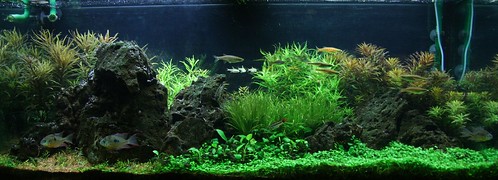 Â
Â
Posted in 75G Tank Log | Comments Off on 75G – This week’s photo
February 6th, 2007
This was posted on the forums, but I wanted to re-emphasize its importance. It appears that the native habitat of the Galaxy Rasbora is being threatened due to overfishing by exporters of the aquarium fish. I’m not really sure what we, as hobbiests, can do to help except to avoid buying Galaxy Rasboras that aren’t captive bred. Unfortunately, most LFS’ don’t know or display such information.
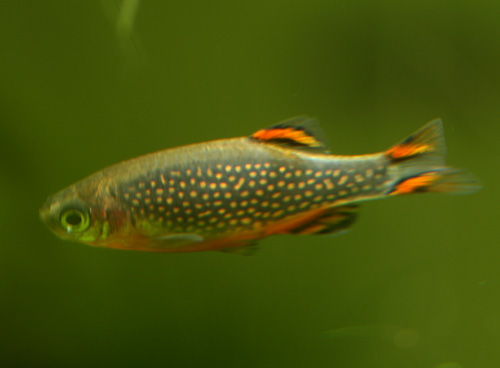
I’m a little bit conflicted because as I mentioned a few weeks ago, I recently purchased a bunch of these beautiful fish after coming across a deal I couldn’t refuse. I’ve been feeding them black-worms, so now I think I’m going to do my best to breed these guys. Unfortunately, there’s not a whole lot of information about their spawning parameters due to their newness to the hobby. Please comment if you know how to breed these fish.
Update: I manage to come across a link to another site that details how they’ve successfully bred the Galaxy Rasboras. Here’s the link: http://www.aquamoss.net/Articles/Microrasbora-sp-Galaxy.htm
Posted in Fish Profiles, General | 7 Comments »
February 6th, 2007
 At the December GWAPA meeting, I was fortunate enough to obtain Pogostemon yatabeanus in the mini-auction that we have at every club meeting. P. yatabeanus is an Austrailian plant, from the same reknowned genus as Pogostemon stellatus, formerly Eusteralis stellatus. This particular species reminds me more of the broadleaf variety of P. stellatus, in that it’s a little bit larger of a plant, except that it stays a beautiful bright green instead of bronzing under bright light. It doesn’t seem to be particularly demanding if kept in your typical high-tech setup.
At the December GWAPA meeting, I was fortunate enough to obtain Pogostemon yatabeanus in the mini-auction that we have at every club meeting. P. yatabeanus is an Austrailian plant, from the same reknowned genus as Pogostemon stellatus, formerly Eusteralis stellatus. This particular species reminds me more of the broadleaf variety of P. stellatus, in that it’s a little bit larger of a plant, except that it stays a beautiful bright green instead of bronzing under bright light. It doesn’t seem to be particularly demanding if kept in your typical high-tech setup.
I currently have the plant in my 75G, planted in Soilmaster Select ‘Red’, with pressurized CO2, high-light, and regular dosing. In this environment, P. yatabeanus might be the fastest growing plant in the tank. Young stems stay rather slender with narrower leaves. Older stems can grow quite thick, with leaves that become longer and fatter, similar to how P. stellatus ‘broadleaf’ grows. When you trim P. yatabeanus and leave the lower portion in the substrate, 2-3 new stems start to grow out of the incision.
Due to this plant’s size, I don’t know if I’d recommend it for a smaller tank, but in a larger tank I think it’s the perfect ‘green’ companion to plants such as limnophilia aromatica, pogostemon stellatus ‘broadleaf’, etc… If you can get your hands on this plant, please give it a try.
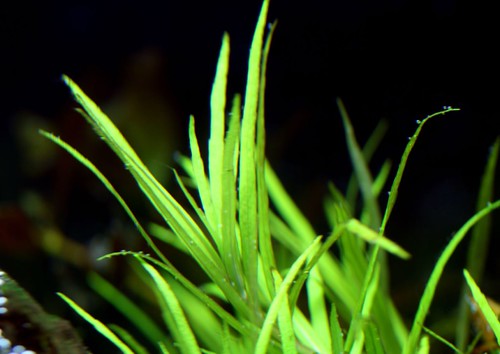
Posted in 75G Tank Log, Plant Profiles | Comments Off on Pogostemon yatabeanus
February 4th, 2007
A year or two ago, GWAPA placed a group order for a number of apistogramma. In that order, I got about 6 apistogramma borellii fish. I successfully bred these guys in a 20G high and had at couple generations going. Then, unfortunately, while I was in California at the AGA, my CO2 tank
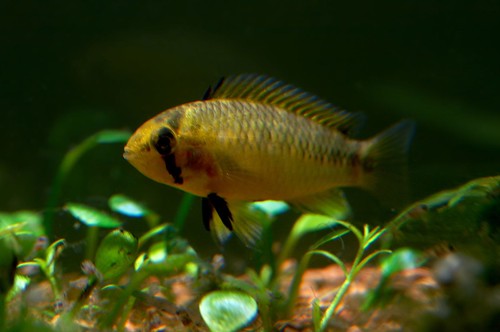
Apistogramma borellii female with babies (lower right) |
dumped the remainder of the canister into this aquarium, and killed off all of my adult fish. All of the smaller fish in the tank survived, including 5-6 borellii babies, which at the time were not sexable. I decided to dedicate a 20G long tank to try and get a new population going. After a couple months of blackworm feeding to get the fish in good breeding shape, I finally noticed the drab juevenilles coloring up — bright yellows and blues! I noticed that a pair formed, which kept 2-3 other males to the outer parts of the tank. Then, this weekend I finally see the female hovering around with a handful of babies. To get an idea of perspective, this female fish is probably only 1.5 inches long. The babies are mere millimeters. Those large looking foreground plants are marselia quadrafolia! It seems that the female has taken to guarding the fry. I haven’t seen the male near them yet.
Posted in 20L Tank Log, Fish Fry, Fish Profiles | 2 Comments »
February 2nd, 2007
I few months ago, I bought a plant from SCALES that was labeled “Rotala indica ‘Red’.” I believe this plant is probably the same thing as Rotala sp. ‘Colorata,’ but at least one GWAPA member believes this is the “real” rotala indica. Either way, this is a gorgeous stem plant that doesn’t need a ton of light to get some very vibrant red tones.

I’ve also noticed that this rotala will start to grow horizontally much more readily than many other rotala’s I’ve tried. As it does this, it sends up multiple vertical stems which can eventually be trimmed and replanted as their on stalk. The plant definitely takes off when CO2 is added, but it seems to grow, albeit much slower, without the added carbon injection. Right now I’m growing this using all SeaChem products in my 20L.
Posted in 20L Tank Log, Plant Profiles | Comments Off on Rotala indica ‘Red’
 Previously, I’ve posted pictures of my Blyxa aubertii flower. Now, I’ve noticed that some of the Blyxa Japonica, that has been floating toward the top of the surface for some time, has also flowered! From my untrained eye, it’s quite difficult to tell any difference from the two flowers, but I suppose that why the two plants are so closely related.
Previously, I’ve posted pictures of my Blyxa aubertii flower. Now, I’ve noticed that some of the Blyxa Japonica, that has been floating toward the top of the surface for some time, has also flowered! From my untrained eye, it’s quite difficult to tell any difference from the two flowers, but I suppose that why the two plants are so closely related.








